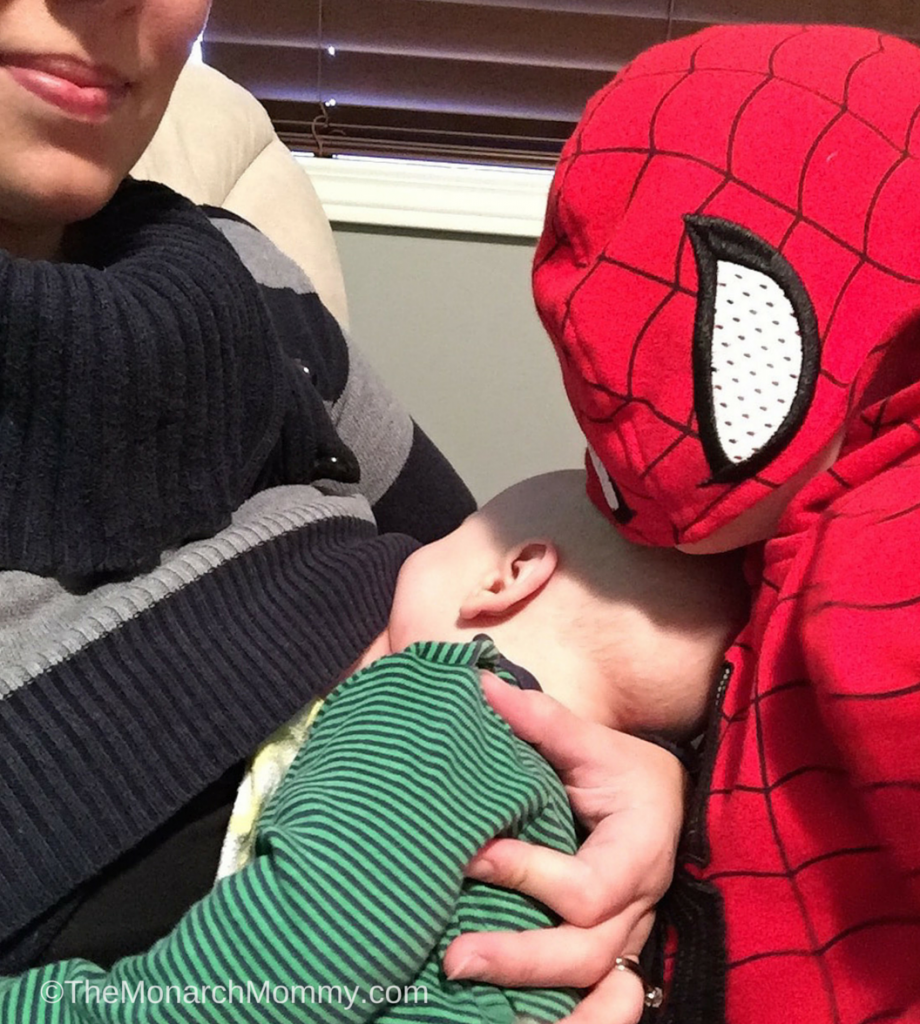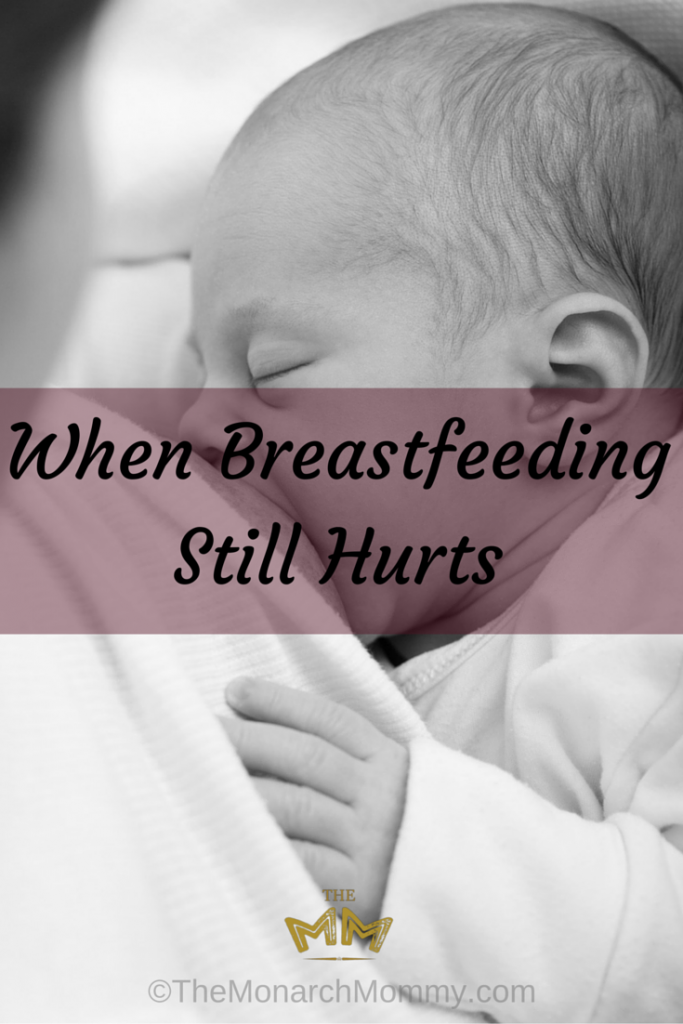Updated on November 19, 2015
When Breastfeeding Still Hurts
It’s not uncommon for the early days of breastfeeding to be accompanied by pain. When baby latches in that first week, it can be downright toe curling. It takes some time for both mom and baby to learn how to breastfeed and that learning process usually involves some nipple pain here and there. Typically, breastfeeding starts to get easier and become pain-free by the time baby is around six weeks old. But what if that doesn’t happen? What if the pain remains? Breastfeeding shouldn’t hurt beyond those early weeks, and if it does, there’s one thing you most definitely want to have ruled out. It could be a tongue tie, and I’m going to tell you why that matters.
Breastfeeding Petit Prince has proved to be a little more challenging than it was with The Heir. With The Heir, I never had any “nipple trauma” (cracks, blisters, etc.) and after the initial weeks, we carried on without any further discomfort to me. It was great! With Petit Prince, it hasn’t been so comfortable. That first week started out as I expected with some toe curling pain while he learned how to latch, but as the week went on the pain worsened. By the time he was four days old, I had cracked and bleeding nipples. One side was worse than the other, but nevertheless, they were sore. My midwives checked him for a tongue tie, and he didn’t seem to have one. It seemed to just be an issue of Petit Prince needing a deeper latch. That was no problem, I could definitely work on that. And work on that I did, and things did improve for a little while, but no matter what I did, there was almost always some level of pain when he latched. One week it would seem to be worse on one side, the next week it would seem to be worse on the other side. Back and forth the pain went, and I kept working on his latch. I’d unlatch and relatch, unlatch and relatch, and eventually I’d just deal with the discomfort. It didn’t occur to me that he could have a tongue tie, but when I ended up with a cracked and bleeding nipple when Petit Prince was three months old I began to wonder if maybe he was tongue tied after all.
What is a tongue tie? A tongue tie is when the movement of the tongue is restricted by a tight frenulum. There are two types of tongue ties: an anterior tongue tie and a posterior tongue tie. An anterior tongue tie is when the frenulum that attaches the tongue to the floor of the mouth extends to the tip of the tongue. A posterior tongue tie is when the frenulum extends further than it should, but not right to the tip of the tongue. A posterior tongue tie still restricts the tongue’s movement. Sometimes when a baby has a tongue tie, their tongue will have an indent at the tip or make a heart shape when the baby tries to stick his tongue out. What does that have to do with breastfeeding? In a word? Everything. If your baby cannot stick his tongue out to cover the lower gum and the lower lip, then his tongue will rub the nipple during feedings leading to nipple soreness, cracks, and bleeding. And that would be the least problematic symptom of a tongue tie. Some babies with a tongue tie are unable to completely empty the breast. This can result in diminished breastmilk supply, and can affect baby’s growth.
When Petit Prince went in for his four month vaccinations, I mentioned my recurrent nipple pain to the public health nurse and asked her to check for a tongue tie. He’d been checked when he was under a week old, but I just needed to rule it out so I could carry on working on his latch hoping he’d outgrow whatever it was that was causing me so much pain. I was fairly certain he didn’t have a tongue tie. He was gaining weight well and staying on his curve for growth (contrary to The Heir who dropped off his curve by four months old), and my breastmilk supply was excellent. Surely that wouldn’t be the case if he was tongue tied. When the nurse checked, much to my surprise, she was fairly certain he had a tongue tie. She asked for another nurse with more experience with tongue ties to come in and check as well. The second nurse was positive that he had a tongue tie and was surprised no one had caught it before now. It turned out Petit Prince had a posterior tongue tie. It can be more difficult to diagnose a posterior tongue tie because you can’t always see that the frenulum is too tight as it doesn’t extend all the way to the tip of the tongue. That second nurse told me she could feel the tongue tie. I decided I needed to schedule an appointment with the breastfeeding doctor in town, Dr. Evelyn Jain.

I was apprehensive about my appointment with Dr. Jain. Petit Prince was over four months old, and tongue ties are typically addressed within the first month or two after baby is born. The last thing I wanted to do was to make things worse for both Petit Prince and I, or go through with a procedure and have no improvement. When I saw Dr. Jain, she could tell right away that Petit Prince had a tongue tie. She showed me how the frenulum was tight and the membrane holding the tongue to the floor of the mouth was quite thick. Just looking at it, she said that it would appear as though he had a short tongue, but by actually feeling under the tongue and lifting the tongue it was very clear that he had a posterior tongue tie. The recommendation was to have his tongue tie clipped (a procedure known as frenotomy).

I’m not going to lie. Watching him get his tongue tie clipped was hard. Yes, there was some blood. Yes, he cried. I settled him down by walking and rocking him around the room a bit, and then I sat down to nurse him. Could I feel a difference with that first nursing session? Umm, yes. It was instantly less “pinchy” feeling when he latched on and I didn’t feel the need to unlatch and relatch him. That was good. Since the procedure, it has continued to improve. It’s actually comfortable to nurse him on both sides and I don’t need to unlatch or relatch him much at all. Of course occasionally he just gets a bad latch (what baby doesn’t?), but nursing him is pretty well pain-free. It’s taken some time for my nipples to recover from four months of painful breastfeeding, but the difference between what it felt like to nurse Petit Prince before his tongue tie was clipped and what it’s like to nurse him now is like night and day.

I’m sharing my experience with a baby with a tongue tie in the hopes that it helps other moms to ask more questions if breastfeeding is painful. If you’re still experiencing nipple pain beyond the first month or so of baby’s life, talk to your care provider. If they aren’t certain or you’re not confident in their assessment, find a breastfeeding clinic in your area, and ask a lactation consultant. I’m not saying that all breastfeeding pain can be explained by a tongue tie, but it is one possibility that should be ruled out if you’re experiencing nipple trauma after the initial few weeks.

Did any of your babies have a tongue tie? How did it affect your breastfeeding relationship?














I’ve heard of a tongue tie before, but wasn’t sure what it was or that it could impact breastfeeding so much. Thanks for the great information.
You’re welcome! You’re not the only one that hadn’t heard about this!
How did they clip it? I’ve heard some are done with lasers… I have to get my baby done in a couple of weeks (when they call me).
The doctor used surgical scissors to clip it. They applied a numbing cream to it first. I’d heard about it being done with lasers too, but that’s not how the breastfeeding doctor did them.
You mentioned The Heir dropping off his weight curve at 4 months. Did the doctor there have a problem with this? Both of my girls have done this now. With my first dd, the Dr immediately wanted us to supplement. Thankfully, I knew better. I found an lc, got in touch with our local lll, and switched drs.
And as a side, both my dds had ppt and ult. My first wasn’t diagnosed and corrected until 14 months. We struggled with pain, plugged ducts, reflux, weight issues for months. We knew what to look for with dd2, and she was revised at 3 weeks. Thank you for bringing attention to this issue!
Yes and no. Our family doctor at that time (we have a different one now) was more concerned about his weight around the 7-8 month mark. Before then he figured his weight would increase once he started solids after 6 months. At that point we were referred to a pediatric nutritionist. She had me track his feedings and the solids he was eating for one month. He gained quite a bit of weight in that one month, so she had absolutely no concerns with his weight at all.
The Heir was born at the 95th percentile for weight and was down to the 25th or so by 4 months. I talked to the public health nurse about it, and she said that it is quite common for breastfed babies to drop around that age. She said that as long as he stays on his new curve it was perfectly fine. He did stay on his new curve, so I didn’t worry about it. Often, breastfed babies’ growth charts look more like stairs (rising, then staying flat/dropping a curve, then rising, then staying flat, etc.) than like a true curve. I did not end up being asked to supplement The Heir.
I’m glad we didn’t have to deal with this, and sad you had to deal with it for so long!
Yeah, it’s so much better now though!
I am a nurse, and I believe that my knowledge about benefits helped me to not quit. I sometimes have let down pain but usually when more milk has started to come in after baby has demanded more feedings. It still does tend to feel a bit sore when milk comes in once in a while & he’s almost 1 year old. My friend has also reported let down pain. She had a major abundance of milk due to over pumping after every feeding. But the majority of the pain in the beginning weeks were due to poor latch. After making sure he took in most of the aerola rather than just the nipple it was so much better!
wow, i had one baby that it hurt no matter what, i was led to believe that stopping the nursing was the only way to go.
My son did not but since he was my first there was definitely a nursing learning curve that’s for sure!! I had clogged ducts, blisters, cracked nipples and lots of latch issues!! I stuck with it though and we made it a fabulous 8 months <3
My first and my second were both tongue tied. The difference was that my first was caught before we left the hospital and clipped but my second wasn’t caught until he was 2 month old. I had a similar experience with my second, lots of pain, cracked sore nipples all because of the bad latch. Once we saw a lactation specialist and solved it, and clipped it, things were so much smoother. I am currently pregnant with my third and I will be having them check before we leave the hospital!!
That is an interesting post. I really had not much heard of it, and you explained it so well. I like how you included pictures with the post. I breastfed with no problem. There was the usual pain at first and then everything went fine. I know many Moms can not breast feed and I am glad they are recognizing this now.
I am very late to reply to this, but saw you tagged in maman loup’s post. We had a similar problem. So much pain! My cracks were so severe I’d cry half the times I nursed. A tongue tie was fixed at 8 weeks followed by a lip tie at 12 weeks and I was not fully healed until my lil man was 5 months. I am glad people are making posts like this. I wish I had known more, but had a lactation consultant tell me he was not tongue tied early on. I will be so much more educated for my next child and will push for a solution is a problem arises! Thanks for sharing.